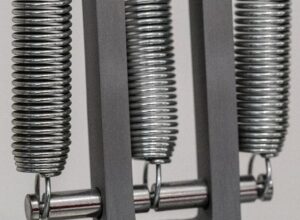Calculation method of tension spring
The calculation of tension, deformation and strength of tension spring is basically the same as that of compression spring, except that the directions of force, deformation and stress are opposite. Therefore, the basic calculation formula for compression springs can also be applied to tension springs.

The initial tension is directly related to the type, performance, diameter and winding ratio of the spring, the type and length of the earring, and the processing method of the spring.
The stretched close-coil springs formed by cold-drawn and strengthened steel wire and cold-rolled have a certain initial tension.
Compared with the spring made of stainless steel wire and carbon spring steel wire, the initial tension is about 12% smaller. The higher the temperature of the spring stress relief and tempering treatment, the lower the initial tension; the spring needs to be heat treated and quenched. Just cast a preliminary pull.
Calculation formula of tension spring
Within the elastic limit, the elastic force of the tension spring is proportional to the amount of deformation (elongation or compression) of the spring. Writing: F=k·x where: “F” means the elastic force of the spring, which is the force applied to the force when the spring deforms. “X” is the length of the spring that is stretched or shortened. Note that “x” is based on the length of the spring without deformation, that is, x=x’-x0 or x=x0-x’.

“K” is called the stiffness coefficient of the spring. It describes the magnitude of the elastic force generated by the unit deformation. The large value of k indicates that the force required for the deformation unit is large, or the spring is “hard”. k is related to spring material, length, thickness, etc. The international unit of k is cattle/meter.
If several identical springs are connected in series or in parallel, the stiffness coefficient of this new spring is no longer the original stiffness coefficient. Assuming that the stiffness coefficient of two springs with both stiffness coefficients k in series is k1, then F=k1·x. Since the elastic force at point a is also F, the two stiffness coefficients can be written for spring 1. When the springs with the same original length of k are connected in parallel, the stiffness coefficient is k2, then the number of F=k2·x becomes smaller, and the one becomes larger after paralleling.






